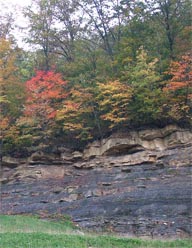Teaching
Forestry 214 - Tree Biology
The goals of arborists, foresters, and horticulturists are very similar in that all wish to control the growth and maximize the health of trees. In order to understand growth, and why trees grow differently in various environments and with different silvicultural treatments, it is necessary to understand physiological processes. This course examines the factors influencing the quantity and quality of tree growth. We will investigate the the structures and functions of woody plants, how these differ between species, and how they are adaptations to their environment. The course generally takes an ecophysiological approach, examining the response of trees at the level of the whole-plant and tissue. The coursework will explore cellular and molecular processes at an introductory level to give the student an understanding of new technology, and an integrated view of plant response to the environment.
Try this link for fun: Tree Anatomy
Forestry 414 / 514 - Tree Physiology
This course is a survey of current literature and methodology in tree
ecological physiology. Through lab excercises and an independent experiment
students learn how to make physiological measurement, and understand how
changes in physiology affect tree growth. Readings and discussion focus
on new findings in physiology, stresses on trees, and on the process of
research from experimental design and methodology to statistical analysis.
Undergraduate Research in Tree Physiology (FOR 493)
Undergraduate students are encouraged to participate in our research
program, and may receive up to 6 credits per year by registering in FOR
493. Students will work closely with a graduate student and the instructor
in designing and carrying out an independent study. This research project
can be used to fulfill one of the requirements in the College of Agricultural
Sciences and Natural Resources honors program.
Forestry, Wildlife and Fisheries 312 - Principles of Silviculture
Course materials cover principles for treating forest stands to achieve selected objectives. Includes natural and artificial regeneration methods, and management methods for even and uneven-aged stands. This course is required for all forestry and wildlife students, and is taken in the fall of the junior year.
Taught with Dr. Wayne Clatterbuck
Forestry 305 - Prescribed Fire Management
This course is designed to provide students with the knowledge necessary to carry out prescribed burning for forest management. The course is part of Spring Block in which all forestry and wildlife juniors participate. Fire behavior and the ecological significance and consequences of fire will be covered.
Forestry, Wildlife and Fisheries 535 - Environmental Impacts to Natural Ecosystems
The course covers current topics in the human disturbance to forested ecosystems, including climate change, acidic deposition, and invasive species. management options to minimize or mitigate distrubance will be disussed, as will afforestation methods for drastically disturbed lands. Offered every second year.

Contact Information
Jennifer Franklin
Dept. of Forestry, Wildlife & Fisheries
274 Ellington Plant Sciences
Knoxville, TN 37996
Phone: (865) 974-2724
Email: jafranklin@utk.edu


